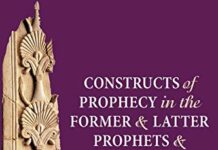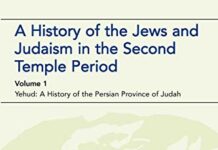
Ebook Info
- Published: 2017
- Number of pages: 352 pages
- Format: PDF
- File Size: 12.57 MB
- Authors: Lester L. Grabbe
Description
In Ancient Israel Lester L. Grabbe sets out to summarize what we know through a survey of sources and how we know it by a discussion of methodology and by evaluating the evidence. The most basic question about the history of ancient Israel, how do we know what we know, leads to the fundamental questions of Grabbe’s work: what are the sources for the history of Israel and how do we evaluate them? How do we make them ‘speak’ to us through the fog of centuries? Grabbe focuses on original sources, including inscriptions, papyri, and archaeology. He examines the problems involved in historical methodology and deals with the major issues surrounding the use of the biblical text when writing a history of this period. Ancient Israel provides an enlightening overview and critique of current scholarly debate. It can therefore serve as a ‘handbook’ or reference-point for those wanting a catalogue of original sources, scholarship, and secondary studies. Grabbe’s clarity of style makes this book eminently accessible not only to students of biblical studies and ancient history but also to the interested lay reader. For this new edition the entire text has been reworked to take account of new archaeological discoveries and theories. There is a major expansion to include a comprehensive coverage of David and Solomon and more detailed information on specific kings of Israel throughout. Grabbe has also added material on the historicity of the Exodus, and provided a thorough update of the material on the later bronze age.
User’s Reviews
Editorial Reviews: Review “Grabbe’s book provides the scholar and teacher with a useful resource for understanding not only the primary sources for the history of ancient Israel, but the major issues and debates facing contemporary scholarship. All of this is presented in a highly organized and accessible volume complete with an enormous bibliography (seventy pages) and a helpful index to biblical and non-biblical texts and inscriptions … Ancient Israel is an indispensable tool for anyone teaching a course on ancient Israel and its environs or the Hebrew Bible.” – Reading Religion About the Author Lester L. Grabbe is Professor Emeritus of Hebrew Bible and Early Judaism at the University of Hull. He is founder and convenor of the European Seminar in Historical Methodology. A recent book is Ancient Israel:What Do We Know and How Do We Know it?
Reviews from Amazon users which were colected at the time this book was published on the website:
⭐The book’s strength is its gathering the historical and archaeological evidence on the one hand and key biblical passages on the other and juxtaposes them. It makes for a helpful reference work. Apart from that, unfortunately, it has things the wrong way around.All the historical and archaeological information the author gathers conspires to create one plausible finding: there never was such a thing as “Ancient Israel” (not his chosen title, but his editor’s, so he tells us). What this information does tell us is that during the Iron Age (say, 1000-539 BC) in the Southern Levant there was a multitude of city-states and smaller territorial states, among them one centred on the northern central highlands known to the Assyrians as “Samaria” or “House of Omri”, with a material culture influenced by Syria and Phoenicia, and from the Assyrian conquest onwards (c.720 BC), the Assyrian and consequently Babylonian cultures, as well as, from time to time, by the Egyptian (who controlled the neighbouring low-lands for extended periods). The author makes much of a reference to “Israel” in a 1200 BC Egyptian inscription, but that may just as well, and arguably far more plausibly, be to “Jezreel” (a region truly important to the Egyptians for many centuries, already in the late Bronze Age, since strategically located on the maritime road from Egypt to Phoenicia and to Damascus); “Israel” to the Egyptians in 1200 BC would have had no referent. There appear to be one or two references to Samaria as “Israel,” but if these are indeed authentic (which is not certain), they may indicate that at some point the kings of Samaria used this term to denote (the references to Samaria or Omri do not stop till the Assyrian conquest, so there is no indication that “Israel” superseded them, but it could have complemented them at some point or another. The dating of these apparent references to “Israel” may well itself be circular: they may be dated based on parallels to biblical passages and hence on the basis of the biblical chronology, not based on independent dating techniques, so the first mentioning of “Israel,” if authentic, could by much later than held by the research community the author refers to (most of them appear to be, like himself, biblical scholars rather than historians). It does not matter: even if Samaria at some point came to be known to some people as “Israel” (doubtful, but not impossible), it was never an entity that the author wishes to denote as “Israel.” For the “Israel” of his title includes another state, in the southern central highlands, centred on Jerusalem, that became properly a state perhaps only after the northern neighbour Samaria had been annexed into Assyria. This more southerly state, much less populated, much less developed than Samaria, may at some point (perhaps in the late 7th or 6th century BC) have become known as Judah, and it was never part of the same state as Samaria. They did not even really exist, as states, in parallel, but rather sequentially: Judah really only came into its own after Samaria had fallen to Assyria, in part no doubt because of migrants fleeing Samaria, in part because the Assyrians did not stop with Samaria, but in 701 BC also destroyed Jerusalem’s biggest rival, Lachish. Only from c.700 BC onwards did Jerusalem gradually prosper and began to dominate the southern highlands, first perhaps as a city-state, eventually as a small territorial state, vassal of Assyria, eventually in c. 580 conquered by Babylon.There never was, according to archaeological evidence,” a “unified kingdom”, nor, therefore, a “divided kingdom.” There were two small states that existed in the central highlands sequentially (Samaria continued to prosper as Assyrian, then Babylonian, then Persian province, as did Judah, separately, so they coexisted only really as dependencies, not as sovereign states). Their relation with each other would not have been any different from any of the many other small states in the region, was it not–and this is key–for one thing: both seem to have made YHWH their dominant deity (in the north, after lengthy competition between YHWH and Baal). The one thing, other than a shared topography, that tied Samaria and Judah together, more than with other neighbours, was the YHWH cult. It is unfortunate that this critical element is barely considered by the author. For the reason why he and many other today try to reconstruct a history of “Ancient Israel” is precisely because the Hebrew Bible–the story of YHWH and his chosen people–tie them together. Archaeology and history do not–the biblical narrative does. And presumably it does so precisely, and only, because both separate “houses” propagated the YHWH cult. Only retrospectively and only in writing, was there one “Israel.” There never was an ancient state or geographical entity that corresponded to this name, but at some point a powerful concept by that name was created. I shall not here try to argue when this concept of “Israel” was created, by whom, and for what reason. It would take me too far, it requires a book. Suffice to say that THIS is the real question of the “history of Israel.” And Grabbe’s book does not even start to address this question.
⭐Lester Grabbe is not a household name in the Western hemisphere. However, in Europe, he is a highly respected scholar of Ancient Israel and Second Temple Judaism. He is a brilliant and disciplined historian and a noted textual critic. In the mid-nineteen nineties, he founded the European Seminar on Methodology in an attempt to foster academic consensus in this contentious area of scholarship. Under Grabbe’s leadership, this Seminar has been very productive, and its work well received. And, by his own admission, it has failed to bring about the consensus that he sought. Members of the Seminar represent a variety of scholarly opinions from conservative to minimalist. Biblical literalists have chosen not to join this group, however, over time they have become less and less a factor in the academy. Commendably, Grabbe in this work considers all positions from those of William Albright in archaeology and John Bright in history to those of Niels P. Lemche and Thomas L. Thompson.The book is arranged in three sections, an introduction to methodology, historical investigations, and a conclusion. Also, included is a massive bibliography heavily weighted to archaeological studies as well as three indexes which cover ancient sources, modern authors, and subjects. It should be noted that the author’s working title for this project was “Prolegomena to a History of ancient Israel…” Therefore, this is but a prelude to the writing of a history of ancient Israel. This is a reference and analytical work covering all the currently known sources of information on the topic. Primary sources contemporary with the actual events are considered paramount followed in importance by secondary sources, such as the Bible, from antiquity, and then lastly modern scholarly works. However, any future scholar who might wish to disregard this work would do so at his own peril. The author’s exposition of what we know at present coupled with his analysis of this material acts as a massive delimiter on any future history of ancient Israel barring new discoveries of primary and/or secondary sources.Chapter one is a prolonged discussion of “Principles and Methods.” This is primer on how history is done. It also discusses some of the particular problems facing the historian of ancient Israel including high versus low chronologies, forged artifacts, and ideology. On one hand, Grabbe finds very little common ground with the American schools of Biblical archaeology and Biblical history epitomized by Albright and Bright and their successors. But on the other hand, he is critical of the minimalists. And, he loathes the general lack of methodological rigor displayed in far too much of what passes for scholarly production coming out of religious studies programs and schools of theology. Furthermore, Grabbe especially decries the shallow imposition of social science methodologies and models on ancient history which is so prevalent in much of modern liberal scholarship.The historical investigation section is divided by chronology into chapters and displays an evenhanded approach towards both the sources and previous scholarship. In short, Grabbe finds no verification of the patriarchal narratives, and that there may be some basis for the exodus story which is currently unknowable. The traditions of Saul, David, and Solomon have historical value but not in the form presented in the Old Testament, and there is no support in the sources for the unified monarchy or the Solomonic empire. It is only with the advent of the Omri dynasty in Israel around 850 BCE that our knowledge of some events becomes verifiable. Our knowledge of Judah based on the primary sources is even later and dates to the mid-eighth century BCE at the earliest. However, as one approaches 586 BCE the terminus of the history of ancient Israel, we know more and more about Judah. And, much of this can be cross referenced into the Biblical accounts with confidence. The synthesis section at the end of each chapter compliments the facts and the analysis preceding them. The conclusion is but a short synopsis of the synthesis materials. If you are anything but a most advanced scholar of the history of ancient Israel, I commend this book to your attention. There is much to learn here regardless of your theological predilections.
⭐Most of my reviews are very positive – this is something of an exception. Let’s start with some good points. Grabbe has done a commendable job in summarising, in one quite short volume, a broad spectrum of fact and opinion concerning ancient Israel. He sets himself the task of covering about 1500 years (c.2000-539BCE) in just over 200 pages, genuinely seeking to present fairly something of the diverse views on this period. The book includes copious references for those wishing to look further. Each section (a span of time identified by its archaeological designation) includes a review of sources (the Bible, non-biblical texts and archaeology), a summary of findings from each, and an appraisal of to what extent there is agreement between the sources.The problems arise as a direct result of this noble attempt to be both wide-ranging and fair: in the periods most of interest to me then the level of detail is low, and on almost every page I found myself thinking, “but why doesn’t he talk about such-and-such?” Ultimately this – however necessary – skating over details became a disappointment about what had promised to be such a useful book, and naturally enough my next thought was to wonder if the same was true of the historical periods I know less about.In summary, whilst I still think the book is well written, and attempts to be inclusive of all opinions, I came away from it feeling slightly let down. As a handy broad-brush overview of the state of play in 2007, it could sit comfortably on anyone’s bookshelf, but if you are looking for solid details on a specific period, this may not be your best choice. For real detail and assessment of differing perspectives, you will need a different book… probably several of them!
Keywords
Free Download Ancient Israel: What Do We Know and How Do We Know It?: Revised Edition in PDF format
Ancient Israel: What Do We Know and How Do We Know It?: Revised Edition PDF Free Download
Download Ancient Israel: What Do We Know and How Do We Know It?: Revised Edition 2017 PDF Free
Ancient Israel: What Do We Know and How Do We Know It?: Revised Edition 2017 PDF Free Download
Download Ancient Israel: What Do We Know and How Do We Know It?: Revised Edition PDF
Free Download Ebook Ancient Israel: What Do We Know and How Do We Know It?: Revised Edition




